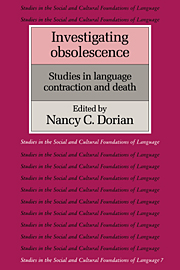Book contents
- Frontmatter
- Contents
- List of maps
- List of contributors
- Preface
- Map
- Dedication
- Introduction
- I Focus on context
- 1 On language death in eastern Africa
- 2 The disappearance of the Ugong in Thailand
- 3 Scottish and Irish Gaelic: The giant's bed-fellows
- 4 The rise and fall of an immigrant language: Norwegian in America
- 5 Breton vs. French: Language and the opposition of political, economic, social, and cultural values
- 6 “Persistence” or “tip” in Egyptian Nubian
- 7 Sociolinguistic creativity: Cape Breton Gaelic's linguistic “tip”
- 8 Skewed performance and full performance in language obsolescence: The case of an Albanian variety
- 9 On the social meaning of linguistic variability in language death situations: Variation in Newfoundland French
- 10 The social functions of relativization in obsolescent and non-obsolescent languages
- II Focus on structure
- III Invited commentaries
- Bibliography
- Index of languages
- General index
5 - Breton vs. French: Language and the opposition of political, economic, social, and cultural values
Published online by Cambridge University Press: 08 January 2010
- Frontmatter
- Contents
- List of maps
- List of contributors
- Preface
- Map
- Dedication
- Introduction
- I Focus on context
- 1 On language death in eastern Africa
- 2 The disappearance of the Ugong in Thailand
- 3 Scottish and Irish Gaelic: The giant's bed-fellows
- 4 The rise and fall of an immigrant language: Norwegian in America
- 5 Breton vs. French: Language and the opposition of political, economic, social, and cultural values
- 6 “Persistence” or “tip” in Egyptian Nubian
- 7 Sociolinguistic creativity: Cape Breton Gaelic's linguistic “tip”
- 8 Skewed performance and full performance in language obsolescence: The case of an Albanian variety
- 9 On the social meaning of linguistic variability in language death situations: Variation in Newfoundland French
- 10 The social functions of relativization in obsolescent and non-obsolescent languages
- II Focus on structure
- III Invited commentaries
- Bibliography
- Index of languages
- General index
Summary
Introduction
The Breton language has been and remains today a powerful symbol of identity for Bretons. Both positive and negative symbolic values attached to Breton are critical variables in this language's persistence and in its impending death. The symbolic opposition of Breton with French is the most important variable in identifying why today Bretons speak most often of language death.
Language use has never been a part of the census of France, but various estimations of Breton speakers have been made by researchers in the nineteenth and twentieth centuries. In 1808 Cocquebert de Monbref estimated 967,000 native speakers, and in 1886 Paul-Yves Sébillot estimated the number to be 1,300,000. The Breton literary group Gwalarn estimated in 1927 that there were one million everyday users of Breton, and Francis Gourvil, a scholar of the Breton language and literature, estimated a figure of 1,200,000 for people who knew Breton. Figures for the 1970s and 1980s vary. Gwennole Le Menn (1975:72), a researcher on Celtic languages for the Centre National de la Recherche Scientifique (CNRS), estimated that 12 years ago there were approximately 1,200,000 people who knew Breton and 300,000 capable of using it as their everyday language, out of a total population in Brittany of approximately 3.7 million. In a 1987 survey of 999 people in Lower Brittany (of a total population of 1.7 million), Fanch Broudic, a Breton-language broadcaster for Radio-France/Bretagne Ouest (FR3), calculated that 61.1 percent understand Breton and 51.7 percent speak it ‘very often’, ‘fairly often’, or ‘sometimes’. The survey showed that an estimated 240,000 Bretons in Lower Brittany use Breton every day (Kuter 1987:4).
- Type
- Chapter
- Information
- Investigating ObsolescenceStudies in Language Contraction and Death, pp. 75 - 90Publisher: Cambridge University PressPrint publication year: 1989
- 28
- Cited by

